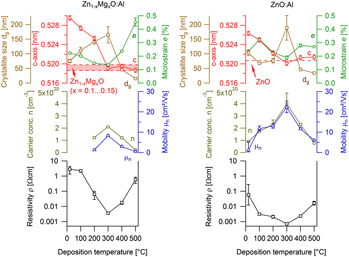Crossref Citations
This article has been cited by the following publications. This list is generated based on data provided by
Crossref.
Bikowski, André
and
Ellmer, Klaus
2013.
A comparative study of electronic and structural properties of polycrystalline and epitaxial magnetron-sputtered ZnO:Al and Zn1-xMgxO:Al Films—Origin of the grain barrier traps.
Journal of Applied Physics,
Vol. 114,
Issue. 6,
Zhu, Bailin
Lü, Kun
Wang, Jun
Li, Taotao
Wu, Jun
Zeng, Dawen
and
Xie, Changsheng
2013.
Characteristics of Al-doped ZnO thin films prepared in Ar + H2 atmosphere and their vacuum annealing behavior.
Journal of Vacuum Science & Technology A: Vacuum, Surfaces, and Films,
Vol. 31,
Issue. 6,
Bikowski, A.
and
Ellmer, K.
2013.
Electrical transport in hydrogen-aluminium Co-doped ZnO and Zn1−xMgxO films: Relation to film structure and composition.
Journal of Applied Physics,
Vol. 113,
Issue. 5,
Welzel, Thomas
and
Ellmer, Klaus
2013.
Comparison of ion energies and fluxes at the substrate during magnetron sputtering of ZnO : Al for dc and rf discharges.
Journal of Physics D: Applied Physics,
Vol. 46,
Issue. 31,
p.
315202.
Kajikawa, Y.
2013.
Effects of grain-boundary potential barrier height and its fluctuation on conductivity of polycrystalline semiconductors in the ionized-impurity-scattering dominated case.
Journal of Applied Physics,
Vol. 114,
Issue. 4,
Bikowski, André
Welzel, Thomas
and
Ellmer, Klaus
2013.
The impact of negative oxygen ion bombardment on electronic and structural properties of magnetron sputtered ZnO:Al films.
Applied Physics Letters,
Vol. 102,
Issue. 24,
Tian, Cong-sheng
Chen, Xin-liang
Ni, Jian
Liu, Jie-ming
Zhang, De-kun
Huang, Qian
Zhao, Ying
and
Zhang, Xiao-dan
2014.
Transparent conductive Mg and Ga co-doped ZnO thin films for solar cells grown by magnetron sputtering: H2 induced changes.
Solar Energy Materials and Solar Cells,
Vol. 125,
Issue. ,
p.
59.
Lipperheide, Reinhard
and
Wille, Uwe
2014.
The Thermoballistic Transport Model.
Vol. 259,
Issue. ,
p.
25.
Bikowski, André
and
Ellmer, Klaus
2014.
Analytical model of electron transport in polycrystalline, degenerately doped ZnO films.
Journal of Applied Physics,
Vol. 116,
Issue. 14,
Chen, Xin-liang
Liu, Jie-ming
Ni, Jian
Zhao, Ying
and
Zhang, Xiao-dan
2015.
Wide-spectrum Mg and Ga co-doped ZnO TCO thin films for solar cells grown via magnetron sputtering with H2 introduction.
Applied Surface Science,
Vol. 328,
Issue. ,
p.
193.
Nie, Man
Bikowski, Andre
and
Ellmer, Klaus
2015.
Microstructure evolution of Al-doped zinc oxide and Sn-doped indium oxide deposited by radio-frequency magnetron sputtering: A comparison.
Journal of Applied Physics,
Vol. 117,
Issue. 15,
Rengachari, Mythili
Bikowski, André
and
Ellmer, Klaus
2016.
Defect analysis by transmission electron microscopy of epitaxial Al-doped ZnO films grown on (0001) ZnO and a-sapphire by RF magnetron sputtering.
Journal of Applied Physics,
Vol. 120,
Issue. 1,
Kou, Kuang-Yang
Huang, Yu-En
Chen, Chien-Hsun
and
Feng, Shih-Wei
2016.
Dependence of lattice strain relaxation, absorbance, and sheet resistance on thickness in textured ZnO@B transparent conductive oxide for thin-film solar cell applications.
Beilstein Journal of Nanotechnology,
Vol. 7,
Issue. ,
p.
75.
Ellmer, Klaus
and
Bikowski, André
2016.
Intrinsic and extrinsic doping of ZnO and ZnO alloys.
Journal of Physics D: Applied Physics,
Vol. 49,
Issue. 41,
p.
413002.
Crovetto, Andrea
Ottsen, Tobias Sand
Stamate, Eugen
Kjær, Daniel
Schou, Jørgen
and
Hansen, Ole
2016.
On performance limitations and property correlations of Al-doped ZnO deposited by radio-frequency sputtering.
Journal of Physics D: Applied Physics,
Vol. 49,
Issue. 29,
p.
295101.
Soliman, Essam S.
Moawed, Sherif A.
and
Hassan, Rania A.
2017.
Influence of microclimatic ammonia levels on productive performance of different broilers' breeds estimated with univariate and multivariate approaches.
Veterinary World,
Vol. 10,
Issue. 8,
p.
880.
Tsai, Chin-Yi
Lai, Jyong-Di
Feng, Shih-Wei
Huang, Chien-Jung
Chen, Chien-Hsun
Yang, Fann-Wei
Wang, Hsiang-Chen
and
Tu, Li-Wei
2017.
Growth and characterization of textured well-faceted ZnO on planar Si(100), planar Si(111), and textured Si(100) substrates for solar cell applications.
Beilstein Journal of Nanotechnology,
Vol. 8,
Issue. ,
p.
1939.
Tsai, Chin-Yi
Lai, Jyong-Di
Feng, Shih-Wei
Chen, Chien-Hsun
Yang, Fann-Wei
Wang, Hsiang-Chen
and
Tu, Li-Wei
2017.
Characterizations and growth of textured well-faceted ZnO films by low-pressure chemical vapor deposition on ITO glass substrates.
Superlattices and Microstructures,
Vol. 111,
Issue. ,
p.
1073.
Chen, Yuyun
Meng, Fanping
Ge, Fangfang
and
Huang, Feng
2017.
Ga-doped ZnO films by magnetron sputtering at ultralow discharge voltages: Effects of defect annihilation.
Thin Solid Films,
Vol. 644,
Issue. ,
p.
16.
Mickan, Martin
Helmersson, Ulf
and
Horwat, David
2018.
Effect of substrate temperature on the deposition of Al-doped ZnO thin films using high power impulse magnetron sputtering.
Surface and Coatings Technology,
Vol. 347,
Issue. ,
p.
245.
